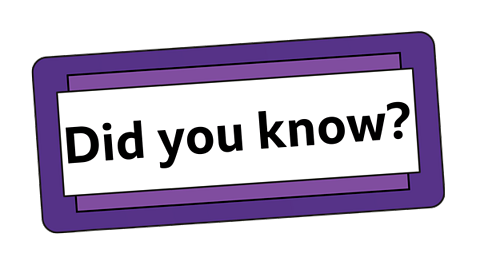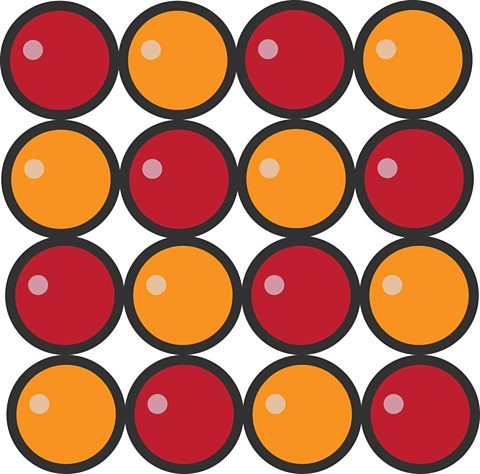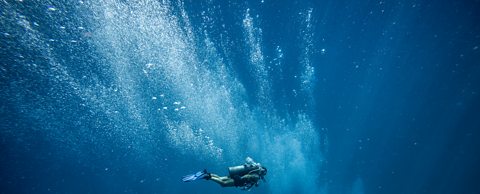Key points
- Letters from the alphabet are used to represent chemical elementA pure substance which is made from only one type of atom. Elements are listed on the periodic table..
- An elementтs chemical symbolEvery chemical element is given a unique symbol, which is either one capital letter, or a capital letter followed by a lower case letter. For example, H represents hydrogen, and Mg represents magnesium. is a single capital letter or a capital letter followed by a lower case letter.
- The periodic tableA table which lists all of the chemical elements and arranges them in a way that is useful. It allows us to spot patterns and make predictions about other elements. shows the chemical symbols for all the different elements.
The formula БстO is used to represent water. What does the formula mean?
The formula БстO shows that water is made from two atoms of hydrogen (H) bonded to one atom of oxygen (O).
Video
Watch this video to learn more about the periodic table, chemical symbols and formulaePlural of formula..
Katie: Time for some science. And today it's a chemistry classic, the periodic table. And here to explain H to the Cs to the Ns and the Os, it's our super scientist extraordinaire, Dr Tim Gregory.
[CHEERING]
Dr. Tim: Hello Katie.
Katie: Hello, Dr Tim. Now, we've got part of the periodic table here. I'm seeing lots of letters. It's a little bit like a giant game of Scrabble. What do they all mean? And what is the table actually used for?
Dr. Tim: So this is the periodic table and each letter on it represents a different element. We call these letters symbols. And an element is a pure substance made from only one type of atom. And there are quite a lot of elements. There are something like 100, and each has a unique symbol made up of a letter and sometimes two letters.
The table is used to arrange the elements and we put chemically similar elements together in groups.
Katie: Amazing! Thank you very much, Dr Tim. Well, before we move on, here's some more information to help us understand the basics of chemical symbols and formulae.
VOICEOVER: Chemical symbols and formulas.
Every element in the periodic table is represented by a unique chemical symbol, like O for Oxygen or Mg for Magnesium.Chemical formulas represent compounds or elements where more than one atom are bonded together. They often, but not always, have little numbers called subscripts that show how many atoms of each element are present in one molecule of a compound.
The chemical formula for Magnesium Oxide, MgO, tells us that there is one atom of magnesium for every one atom of oxygen. Butane, which has the chemical formula АфтHттИі, has four carbon atoms and ten hydrogen atoms. And the formula of sulfuric acid is HтSO4.
And this tells us that one molecule of sulfuric acid contains two hydrogen atoms, one sulfur atom and four oxygen atoms.
Katie: OK, Dr Tim, what's next then?
Dr. Tim: Alright. Take a look at the periodic table there. Are there any symbols that you recognise? Any elements that you might know?
Katie: Erm, how about O for oxygen?
Dr. Tim: Yep, perfect. How about any others?
Katie: I recognise Fe but if it's got two letters like that, does that mean that it's two elements combined?
Dr. Tim: Not quite. Now, remember, on the periodic table we only put elements, not compounds. Fe is actually iron and you can tell this is an element because it's got an uppercase F followed by a lowercase e.
Some elements have two letters in their symbol, because there are more than 100 elements, but there are only 26 letters in the alphabet, so we have to double some of them up.
Katie: OK, so why is it Fe and not Ir like a shortened version of Iron. That would be much easier to remember, wouldn't it?
Dr. Tim: It would be easier, but you know the history of who discovered these elements and when and where is really long and complicated and interesting and the symbols for some of the elements are left over from their old names.
For example, the symbol for iron, Fe, comes from the Latin name for iron, ferrum.
Katie: Oh, wow. I'm learning lots here, sir. How about W? Is that one water?
Dr. Tim: Not quite. W is actually the element tungsten, and the W symbol comes from the mineral in which tungsten is found called wolframite. And tungsten is actually what the filament of some light bulbs is made from, the little spiral filament that lights up when you switch it on.
What are the symbols for the elements magnesium and oxygen?
The chemical symbol for oxygen is O. The chemical symbol for magnesium is Mg.
Symbols and elements
Elements
An element is a substance that cannot be broken down into any other substance. Every element is made up of its own type of atomThe smallest particle of an element. We often think of atoms as tiny spheres, but in fact they are made from smaller particles called protons, neutrons and electrons.. Oxygen, hydrogen, gold, and iron are all elements.
Symbols
Elements are represented by letters from the alphabet. These letters are also known as symbols. The symbol for an element is either a single capital letter or a capital letter followed by a lower case letter.
For example:
| H | hydrogen |
| C | carbon |
| He | helium |
| Mg | magnesium |
| Na | sodium |

A lot of the element names have come from Latin. The Latin name for sodium was 'natrium'.
Which element has the symbol N?
Nitrogen.
The periodic table
There are 118 chemical elements and they are listed on the periodic table in a specific order.
- 94 chemical elements occur naturally on Earth and in the universe.
- 24 elements are made using nuclear reactions.

Scientist Marie Curie discovered two elements: radium and polonium. She discovered that radium could help the body fight cancer cells. Marie became the first woman to win a Nobel Prize.
What are the only two letters of the alphabet to not appear on the periodic table?
Q and J.
Compounds and molecules
Video
Watch this video where Dr Tim explains how compoundA pure substance made from two or more elements which are chemically bonded in a fixed ratio. can be represented by chemical formulae.
Dr. Tim: Water isn't an element, it's a compound. And, remember, we only show pure elements on the periodic table.
Katie: So what's a compound then?
Dr. Tim: A compound is a pure substance which is made from more than one element. And atoms, they chemically bond together in a fixed ratio to make a compound, and this means we can describe these compounds with a chemical formula.
So, since water is a compound, it means its chemical formula is made up from elements that we can pick from the periodic table.
Katie: So which chemicals is water made up of?
Dr. Tim: It's made of two elements. Oxygen, which you've already found, and hydrogen.
Katie: OK, let me find hydrogen. OK, there it is. So H is БстO! Water is БстO. Of course it is. What's the number two all about?
Dr. Tim: Let me write it down to explain.
We've got water with the chemical formula БстO. Just like that. Now, we always put these numbers down at the bottom when we're writing chemical formula and this number, it shows how many of each type of atom we have in the compound. And the two is because for every one oxygen atom there are two hydrogen atoms in water. And if we were to draw the molecule, it would look a little bit like this.
So we've got our oxygen atom and then we've got our two hydrogen atoms. БстO, water. When a compound forms there isn't always an equal number of elements. For example, water, there are two hydrogens and just one oxygen. We use the numbers to show how many of each atom there are in a compound.
Now, another one you'll have heard of is carbon dioxide.
Katie: Yes, so that's carbon and dioxide. So is oxide oxygen?
Dr. Tim: Yes, perfect.
Katie: And 'di' means two, so dioxide means two oxygens?
Dr. Tim: Absolutely spot on, exactly right.
Katie: So, carbon dioxide means a carbon plus two oxygens. That's АфАПт.
Dr. Tim: Excellent. So if we write this down, we've got АфАПт. We've got one carbon atom and two oxygen atoms. And if we draw it, it would look a little bit like this. So we've got our one carbon atom, we've got one oxygen there and another oxygen there. АфАПт, carbon dioxide.
The formula for carbon dioxide is АфАПт. What atoms are in one molecule of carbon dioxide?
Each molecule of carbon dioxide contains one atom of carbon ТЉ and two atoms of oxygen (Oт).
Compounds
AтЏcompoundтЏis a substance that contains atoms of two or more different elements.
The elements are chemically bonded together in a specific ratioAтЏratioтЏshows how much of one thing there is compared to another. of atoms.
The formula of a compound shows how many atoms of each element are bonded together.
The formula is made up of symbols and numbers.
The numbers are written as subscript, which means they are smaller than the symbol, and slightly lower down. For example, the formula for water is БстO.
Examples
Water is a compound of hydrogen and oxygen. The symbols H for hydrogen and O for oxygen are used to represent БстO.
Oxygen gas is a moleculeTwo or more atoms which are strongly bonded together. The smallest particle of a substance that has all of the physical and chemical properties of that substance. made of two oxygen (O) atoms represented as Oт.
Sulfuric acid is a combination of hydrogen (H), sulfur (S) and oxygen (O) represented as HтSOт.
| БстO | Two hydrogen atoms, one oxygen atom | 3 atoms in total |
| АфАПт | One carbon atom, two oxygen atoms | 3 atoms in total |
| АфтHттИі | Four carbon atoms, ten hydrogen atoms | 14 atoms in total |

The plural of formulaA formula is made up of the symbols for one or more element and a subscripted number to show how many atoms of each element are bonded together. is тformulaeт.
Molecules
Most molecules are made of two or more non-metal atoms bonded together.
The structure of compounds
Compounds made from a metal and a non-metal, like sodium chloride, do not form molecules.
They form giant structures like this.

For compounds made from metals and non-metals, the ratio is simplified down as much as possible.
In this example, the formula is NaCl instead of NaтClт.
Calcium chloride has the formula CaClт, so there are twice as many chlorine atoms present as calcium atoms.
Non-metal elements
Many non-metal elementA pure substance which is made from only one type of atom. Elements are listed on the periodic table. are made from moleculeTwo or more atoms which are strongly bonded together. The smallest particle of a substance that has all of the physical and chemical properties of that substance., and these have a chemical formula which shows how many atomThe smallest particle of an element. We often think of atoms as tiny spheres, but in fact they are made from smaller particles called protons, neutrons and electrons. are bonded to each other in their molecules.
Here are some common examples. Most are made from two atoms in each molecule.
- Hт т hydrogen
- Oт т oxygen
- Clт т chlorine
- Nт т nitrogen

Metals donтt form molecules, so always use just the element symbol. For example, Mg for magnesium, not Mgт or Mgт.
Which elements does MgClт contain? How many of each type of atom are present?
MgClт is the formula for magnesium chloride, which is a compound containing magnesium (Mg) and chlorine (Cl). There are two atoms of chlorine for every one atom of magnesium.
Test your knowledge
Play the Atomic Labs game! gamePlay the Atomic Labs game!
Try out practical experiments in this KS3 science game.

More on Atoms, elements and compounds
Find out more by working through a topic
- count4 of 8

- count5 of 8

- count6 of 8

- count7 of 8
